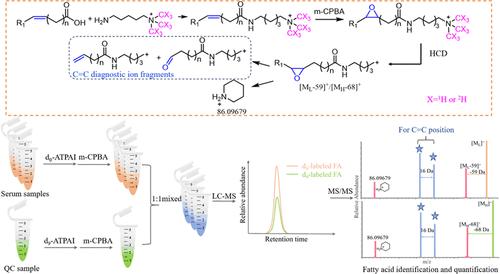Enhancing the Accuracy of Identification and Relative Quantification of Unsaturated Fatty Acids in Serum via a Stable Isotope-Labeled Double Derivatization Strategy
IF 6.7
1区 化学
Q1 CHEMISTRY, ANALYTICAL
引用次数: 0
Abstract
Accurate identification and quantification of fatty acids are critical for investigating their biological function in disease models. Although several derivatization methods have been proposed for identifying the positions of C═C bonds in unsaturated fatty acids, poor ionization efficiency of the carboxyl group leads to lower intensity of molecular ion peaks, making their identification difficult and interfering with the accuracy of quantification based on peak areas of characteristic ion pairs. In this study, a strategy of stable isotope-labeled carboxyl derivatization combined with C═C derivatization was employed for simultaneously the identification and quantification of fatty acids using d0/d9-5-amino-N,N,N-trimethylpentane-1-ammonium iodide (d0/d9-ATPAI) to label the carboxyl group and m-chloroperoxybenzoic acid to label C═C bonds. The stable isotope-labeled quaternary amine groups in the novel carboxyl derivatization reagent d0/d9-ATPAI can enhance the accuracy of the recognition of characteristic ion pairs to facilitate the structural elucidation of various fatty acids. The heavy isotope-labeled fatty acids can be served as internal standards to achieve accurate relative quantification of the C═C position isomers of individual unsaturated fatty acids among samples based on the peak area ratio of the characteristic ion pairs. Unsaturated fatty acid C═C positional isomers were quantified using aldehyde or alkenyl diagnostic ions. In addition, saturated fatty acids were quantified using the m/z 86.09679 cyclamine characteristic ion. This approach enhanced the detection sensitivity of fatty acids by 60,000 times, allowing for the characterization of 70 fatty acids in rat serum, including 26 unsaturated fatty acid C═C positional isomers. Pseudotargeted metabolomics analysis of serum fatty acids revealed alterations in the fatty acid metabolic pathway during diabetic cognitive dysfunction. Overall, the proposed method, with high sensitivity and wide coverage, could provide accurate identification and relative quantification of various fatty acids in complex matrices.

用稳定同位素标记双衍生策略提高血清中不饱和脂肪酸鉴定和相对定量的准确性
脂肪酸的准确鉴定和定量对于研究其在疾病模型中的生物学功能至关重要。虽然已经提出了几种衍生化方法来鉴定不饱和脂肪酸中C = C键的位置,但羧基的低电离效率导致分子离子峰的强度较低,使得它们的鉴定困难,并且干扰了基于特征离子对峰面积的定量准确性。在这项研究中,采用稳定同位素标记羧基衍生化结合C = C衍生化的策略,同时用d0/d9-5-氨基-N,N,N-三甲基戊烷-1-碘化铵(d0/d9-ATPAI)标记羧基,用间氯过氧苯甲酸标记C = C键来鉴定和定量脂肪酸。新型羧基衍生试剂d0/d9-ATPAI中稳定同位素标记的季胺基团可以提高特征离子对识别的准确性,便于对各种脂肪酸的结构进行解析。重同位素标记的脂肪酸可以作为内标,根据特征离子对的峰面积比,实现样品中单个不饱和脂肪酸C = C位置异构体的精确相对定量。采用醛或烯基诊断离子定量测定不饱和脂肪酸C = C的位置异构体。此外,饱和脂肪酸定量采用m/z 86.09679环己胺特征离子。该方法将脂肪酸的检测灵敏度提高了6万倍,可以表征大鼠血清中的70种脂肪酸,包括26种不饱和脂肪酸C = C位置异构体。血清脂肪酸的假靶向代谢组学分析揭示了糖尿病认知功能障碍期间脂肪酸代谢途径的改变。总体而言,该方法灵敏度高,覆盖范围广,可对复杂基质中各种脂肪酸进行准确的鉴定和相对定量。
本文章由计算机程序翻译,如有差异,请以英文原文为准。
求助全文
约1分钟内获得全文
求助全文
来源期刊

Analytical Chemistry
化学-分析化学
CiteScore
12.10
自引率
12.20%
发文量
1949
审稿时长
1.4 months
期刊介绍:
Analytical Chemistry, a peer-reviewed research journal, focuses on disseminating new and original knowledge across all branches of analytical chemistry. Fundamental articles may explore general principles of chemical measurement science and need not directly address existing or potential analytical methodology. They can be entirely theoretical or report experimental results. Contributions may cover various phases of analytical operations, including sampling, bioanalysis, electrochemistry, mass spectrometry, microscale and nanoscale systems, environmental analysis, separations, spectroscopy, chemical reactions and selectivity, instrumentation, imaging, surface analysis, and data processing. Papers discussing known analytical methods should present a significant, original application of the method, a notable improvement, or results on an important analyte.
 求助内容:
求助内容: 应助结果提醒方式:
应助结果提醒方式:


